Business Strategy Report: Starbucks' Strategic Analysis and Planning
VerifiedAdded on 2023/01/11
|14
|4222
|92
Report
AI Summary
This report provides a comprehensive analysis of Starbucks' business strategy, examining the influence of macro factors on its strategic and tactical decisions. It delves into various strategic planning techniques, including benchmarking, business analysis, and stakeholder analysis. The report utilizes PESTLE analysis to assess external environmental factors and applies Ansoff's matrix to explore growth strategies. Additionally, it employs SWOT analysis to evaluate internal strengths and weaknesses alongside external opportunities and threats. The evaluation of capabilities and internal environment is conducted using the VRIO framework and resource-based view strategy. Furthermore, the report incorporates Porter's five forces to determine competitive forces within the industry and discusses theories and models for strategic planning, offering a holistic view of Starbucks' strategic approach.

BUSINESS
STRATEGY
STRATEGY
Paraphrase This Document
Need a fresh take? Get an instant paraphrase of this document with our AI Paraphraser

CONTENTS
Contents...........................................................................................................................................2
TASK 1............................................................................................................................................3
P1 influence of macro factors on business strategies of the organisation..............................3
TASK 2............................................................................................................................................7
P2 Evaluation of capabilities and internal environment.........................................................7
TASK 3............................................................................................................................................9
P3: Porter’s five forces for evaluating competitive forces.....................................................9
TASK 4..........................................................................................................................................10
P4: Theories and models for strategic planning...................................................................10
CONCLUSION..............................................................................................................................12
REFERENCES................................................................................................................................1
Contents...........................................................................................................................................2
TASK 1............................................................................................................................................3
P1 influence of macro factors on business strategies of the organisation..............................3
TASK 2............................................................................................................................................7
P2 Evaluation of capabilities and internal environment.........................................................7
TASK 3............................................................................................................................................9
P3: Porter’s five forces for evaluating competitive forces.....................................................9
TASK 4..........................................................................................................................................10
P4: Theories and models for strategic planning...................................................................10
CONCLUSION..............................................................................................................................12
REFERENCES................................................................................................................................1
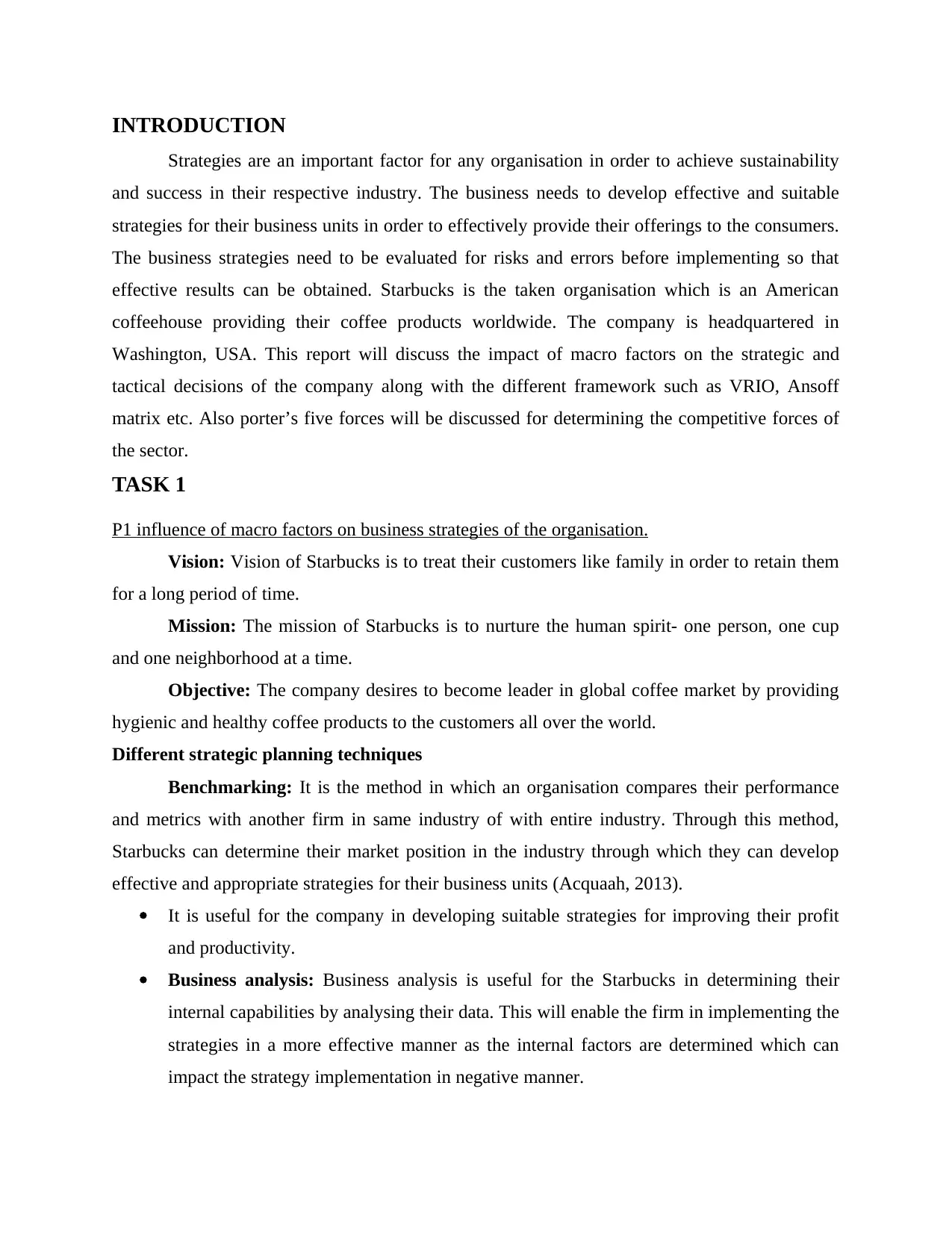
INTRODUCTION
Strategies are an important factor for any organisation in order to achieve sustainability
and success in their respective industry. The business needs to develop effective and suitable
strategies for their business units in order to effectively provide their offerings to the consumers.
The business strategies need to be evaluated for risks and errors before implementing so that
effective results can be obtained. Starbucks is the taken organisation which is an American
coffeehouse providing their coffee products worldwide. The company is headquartered in
Washington, USA. This report will discuss the impact of macro factors on the strategic and
tactical decisions of the company along with the different framework such as VRIO, Ansoff
matrix etc. Also porter’s five forces will be discussed for determining the competitive forces of
the sector.
TASK 1
P1 influence of macro factors on business strategies of the organisation.
Vision: Vision of Starbucks is to treat their customers like family in order to retain them
for a long period of time.
Mission: The mission of Starbucks is to nurture the human spirit- one person, one cup
and one neighborhood at a time.
Objective: The company desires to become leader in global coffee market by providing
hygienic and healthy coffee products to the customers all over the world.
Different strategic planning techniques
Benchmarking: It is the method in which an organisation compares their performance
and metrics with another firm in same industry of with entire industry. Through this method,
Starbucks can determine their market position in the industry through which they can develop
effective and appropriate strategies for their business units (Acquaah, 2013).
It is useful for the company in developing suitable strategies for improving their profit
and productivity.
Business analysis: Business analysis is useful for the Starbucks in determining their
internal capabilities by analysing their data. This will enable the firm in implementing the
strategies in a more effective manner as the internal factors are determined which can
impact the strategy implementation in negative manner.
Strategies are an important factor for any organisation in order to achieve sustainability
and success in their respective industry. The business needs to develop effective and suitable
strategies for their business units in order to effectively provide their offerings to the consumers.
The business strategies need to be evaluated for risks and errors before implementing so that
effective results can be obtained. Starbucks is the taken organisation which is an American
coffeehouse providing their coffee products worldwide. The company is headquartered in
Washington, USA. This report will discuss the impact of macro factors on the strategic and
tactical decisions of the company along with the different framework such as VRIO, Ansoff
matrix etc. Also porter’s five forces will be discussed for determining the competitive forces of
the sector.
TASK 1
P1 influence of macro factors on business strategies of the organisation.
Vision: Vision of Starbucks is to treat their customers like family in order to retain them
for a long period of time.
Mission: The mission of Starbucks is to nurture the human spirit- one person, one cup
and one neighborhood at a time.
Objective: The company desires to become leader in global coffee market by providing
hygienic and healthy coffee products to the customers all over the world.
Different strategic planning techniques
Benchmarking: It is the method in which an organisation compares their performance
and metrics with another firm in same industry of with entire industry. Through this method,
Starbucks can determine their market position in the industry through which they can develop
effective and appropriate strategies for their business units (Acquaah, 2013).
It is useful for the company in developing suitable strategies for improving their profit
and productivity.
Business analysis: Business analysis is useful for the Starbucks in determining their
internal capabilities by analysing their data. This will enable the firm in implementing the
strategies in a more effective manner as the internal factors are determined which can
impact the strategy implementation in negative manner.
⊘ This is a preview!⊘
Do you want full access?
Subscribe today to unlock all pages.

Trusted by 1+ million students worldwide
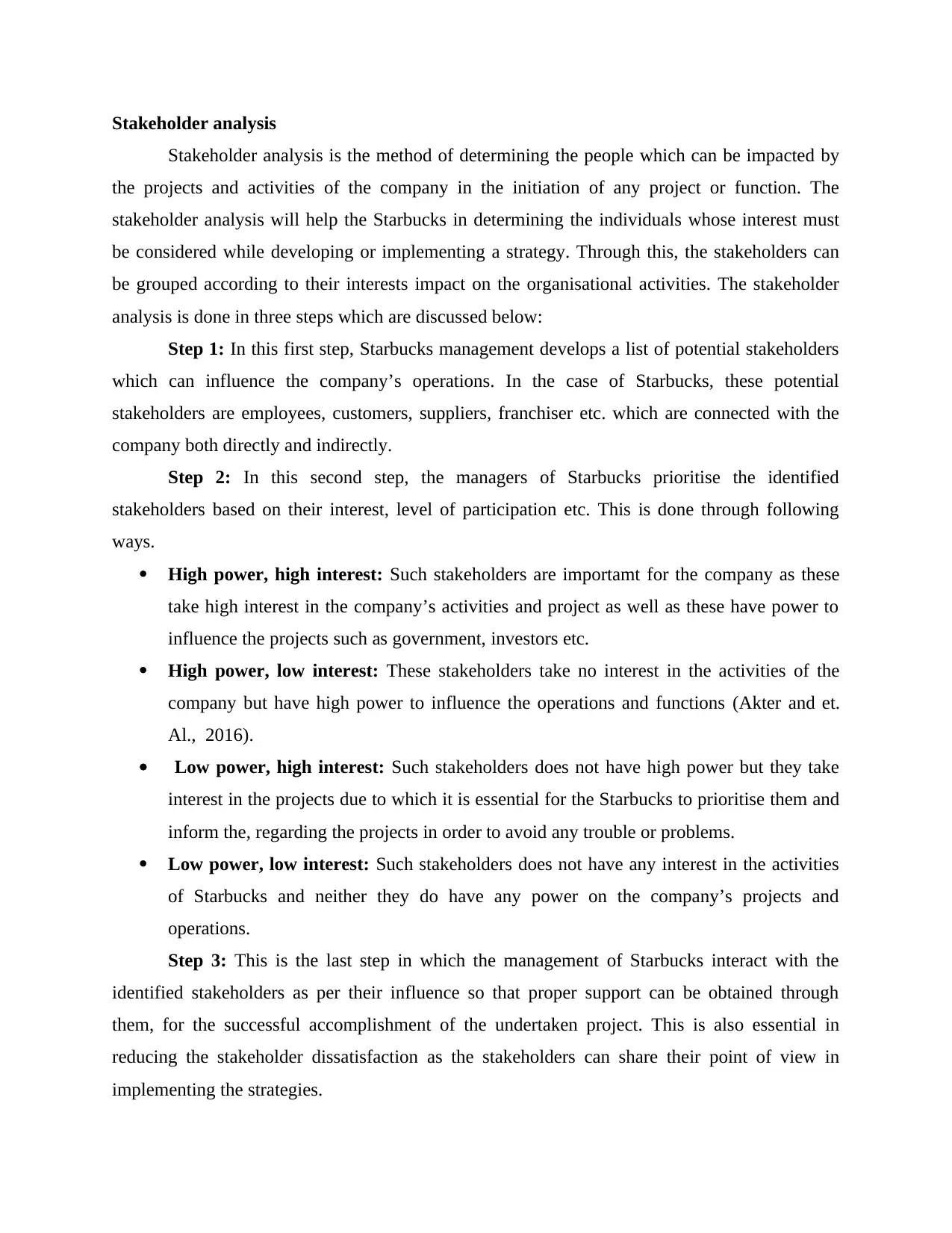
Stakeholder analysis
Stakeholder analysis is the method of determining the people which can be impacted by
the projects and activities of the company in the initiation of any project or function. The
stakeholder analysis will help the Starbucks in determining the individuals whose interest must
be considered while developing or implementing a strategy. Through this, the stakeholders can
be grouped according to their interests impact on the organisational activities. The stakeholder
analysis is done in three steps which are discussed below:
Step 1: In this first step, Starbucks management develops a list of potential stakeholders
which can influence the company’s operations. In the case of Starbucks, these potential
stakeholders are employees, customers, suppliers, franchiser etc. which are connected with the
company both directly and indirectly.
Step 2: In this second step, the managers of Starbucks prioritise the identified
stakeholders based on their interest, level of participation etc. This is done through following
ways.
High power, high interest: Such stakeholders are importamt for the company as these
take high interest in the company’s activities and project as well as these have power to
influence the projects such as government, investors etc.
High power, low interest: These stakeholders take no interest in the activities of the
company but have high power to influence the operations and functions (Akter and et.
Al., 2016).
Low power, high interest: Such stakeholders does not have high power but they take
interest in the projects due to which it is essential for the Starbucks to prioritise them and
inform the, regarding the projects in order to avoid any trouble or problems.
Low power, low interest: Such stakeholders does not have any interest in the activities
of Starbucks and neither they do have any power on the company’s projects and
operations.
Step 3: This is the last step in which the management of Starbucks interact with the
identified stakeholders as per their influence so that proper support can be obtained through
them, for the successful accomplishment of the undertaken project. This is also essential in
reducing the stakeholder dissatisfaction as the stakeholders can share their point of view in
implementing the strategies.
Stakeholder analysis is the method of determining the people which can be impacted by
the projects and activities of the company in the initiation of any project or function. The
stakeholder analysis will help the Starbucks in determining the individuals whose interest must
be considered while developing or implementing a strategy. Through this, the stakeholders can
be grouped according to their interests impact on the organisational activities. The stakeholder
analysis is done in three steps which are discussed below:
Step 1: In this first step, Starbucks management develops a list of potential stakeholders
which can influence the company’s operations. In the case of Starbucks, these potential
stakeholders are employees, customers, suppliers, franchiser etc. which are connected with the
company both directly and indirectly.
Step 2: In this second step, the managers of Starbucks prioritise the identified
stakeholders based on their interest, level of participation etc. This is done through following
ways.
High power, high interest: Such stakeholders are importamt for the company as these
take high interest in the company’s activities and project as well as these have power to
influence the projects such as government, investors etc.
High power, low interest: These stakeholders take no interest in the activities of the
company but have high power to influence the operations and functions (Akter and et.
Al., 2016).
Low power, high interest: Such stakeholders does not have high power but they take
interest in the projects due to which it is essential for the Starbucks to prioritise them and
inform the, regarding the projects in order to avoid any trouble or problems.
Low power, low interest: Such stakeholders does not have any interest in the activities
of Starbucks and neither they do have any power on the company’s projects and
operations.
Step 3: This is the last step in which the management of Starbucks interact with the
identified stakeholders as per their influence so that proper support can be obtained through
them, for the successful accomplishment of the undertaken project. This is also essential in
reducing the stakeholder dissatisfaction as the stakeholders can share their point of view in
implementing the strategies.
Paraphrase This Document
Need a fresh take? Get an instant paraphrase of this document with our AI Paraphraser
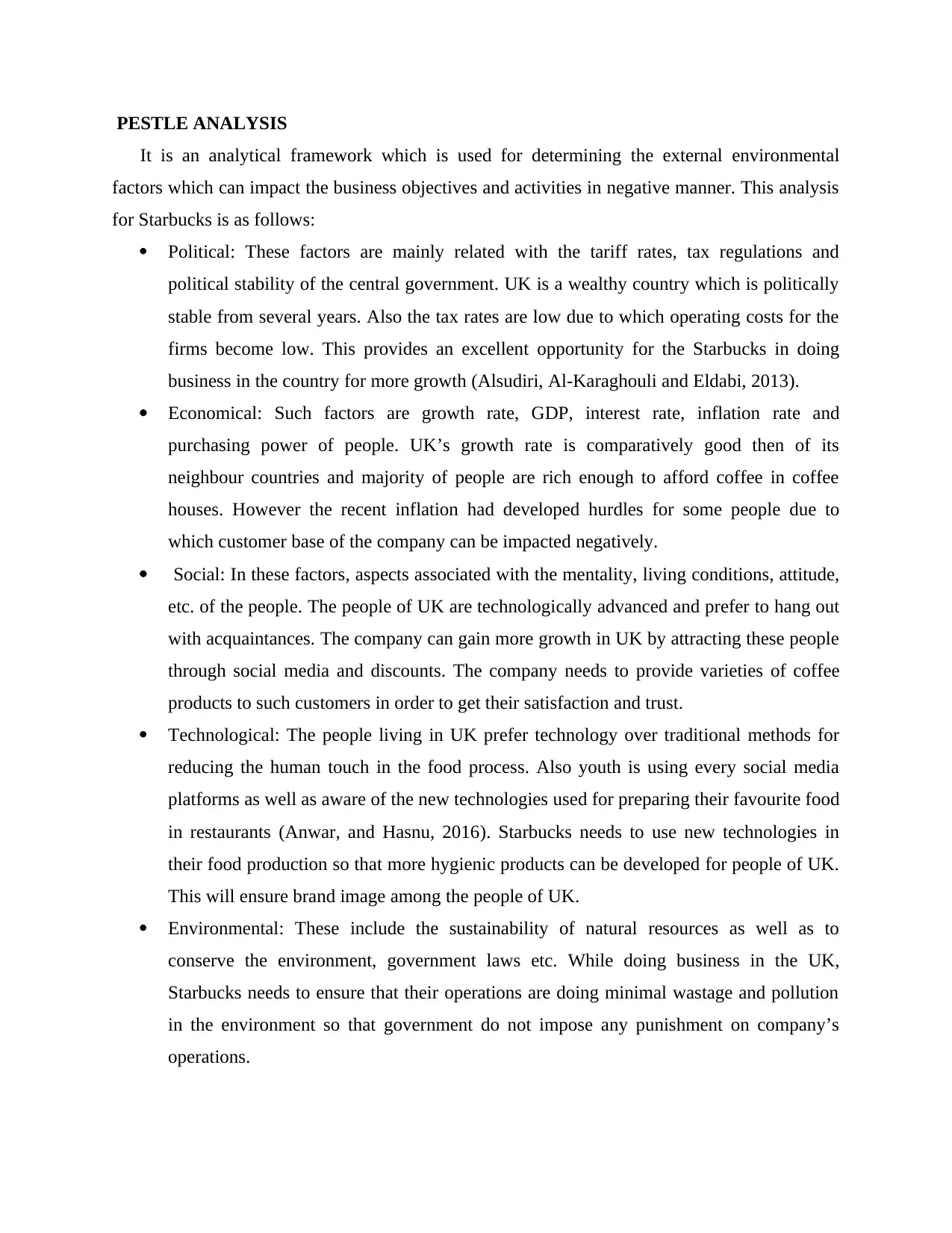
PESTLE ANALYSIS
It is an analytical framework which is used for determining the external environmental
factors which can impact the business objectives and activities in negative manner. This analysis
for Starbucks is as follows:
Political: These factors are mainly related with the tariff rates, tax regulations and
political stability of the central government. UK is a wealthy country which is politically
stable from several years. Also the tax rates are low due to which operating costs for the
firms become low. This provides an excellent opportunity for the Starbucks in doing
business in the country for more growth (Alsudiri, Al-Karaghouli and Eldabi, 2013).
Economical: Such factors are growth rate, GDP, interest rate, inflation rate and
purchasing power of people. UK’s growth rate is comparatively good then of its
neighbour countries and majority of people are rich enough to afford coffee in coffee
houses. However the recent inflation had developed hurdles for some people due to
which customer base of the company can be impacted negatively.
Social: In these factors, aspects associated with the mentality, living conditions, attitude,
etc. of the people. The people of UK are technologically advanced and prefer to hang out
with acquaintances. The company can gain more growth in UK by attracting these people
through social media and discounts. The company needs to provide varieties of coffee
products to such customers in order to get their satisfaction and trust.
Technological: The people living in UK prefer technology over traditional methods for
reducing the human touch in the food process. Also youth is using every social media
platforms as well as aware of the new technologies used for preparing their favourite food
in restaurants (Anwar, and Hasnu, 2016). Starbucks needs to use new technologies in
their food production so that more hygienic products can be developed for people of UK.
This will ensure brand image among the people of UK.
Environmental: These include the sustainability of natural resources as well as to
conserve the environment, government laws etc. While doing business in the UK,
Starbucks needs to ensure that their operations are doing minimal wastage and pollution
in the environment so that government do not impose any punishment on company’s
operations.
It is an analytical framework which is used for determining the external environmental
factors which can impact the business objectives and activities in negative manner. This analysis
for Starbucks is as follows:
Political: These factors are mainly related with the tariff rates, tax regulations and
political stability of the central government. UK is a wealthy country which is politically
stable from several years. Also the tax rates are low due to which operating costs for the
firms become low. This provides an excellent opportunity for the Starbucks in doing
business in the country for more growth (Alsudiri, Al-Karaghouli and Eldabi, 2013).
Economical: Such factors are growth rate, GDP, interest rate, inflation rate and
purchasing power of people. UK’s growth rate is comparatively good then of its
neighbour countries and majority of people are rich enough to afford coffee in coffee
houses. However the recent inflation had developed hurdles for some people due to
which customer base of the company can be impacted negatively.
Social: In these factors, aspects associated with the mentality, living conditions, attitude,
etc. of the people. The people of UK are technologically advanced and prefer to hang out
with acquaintances. The company can gain more growth in UK by attracting these people
through social media and discounts. The company needs to provide varieties of coffee
products to such customers in order to get their satisfaction and trust.
Technological: The people living in UK prefer technology over traditional methods for
reducing the human touch in the food process. Also youth is using every social media
platforms as well as aware of the new technologies used for preparing their favourite food
in restaurants (Anwar, and Hasnu, 2016). Starbucks needs to use new technologies in
their food production so that more hygienic products can be developed for people of UK.
This will ensure brand image among the people of UK.
Environmental: These include the sustainability of natural resources as well as to
conserve the environment, government laws etc. While doing business in the UK,
Starbucks needs to ensure that their operations are doing minimal wastage and pollution
in the environment so that government do not impose any punishment on company’s
operations.

Legal: Such factors includes the laws and regulation imposed by the government on
employing it’s people in businesses. The Starbucks is following laws such as equality act,
anti-discrimination act etc. due to which it enjoy positive image among its employees.
Also company needs to ensure that each and every law is followed for smooth
functioning of the company in UK.
Ansoff's matrix
It is a type of strategic tool which is commonly used by the business firms for
determining the right strategy to expand their business operations and for attaining more growth.
Starbucks can use this strategy as follows:
Product development: This strategy is used by the firms for providing new products to
their customers. Through this, the sales of the Starbucks can be enhanced as existing
people will buy their new products which will enhance the revenue of Starbucks.
Market development: This strategy is useful for the Starbucks in increasing their
customers and market share. Existing products are supplied or provided to new customers
and market which will enhance the sales and profit for the firms (Blackburn, Hart and
Wainwright, 2013).
Market penetration: This strategy is used by the firms by providing discounts on
existing products in existing market. Through this, the market share of the company can
be improved as people will buy their more in quantity due to the discounts and offers.
Diversification: This strategy is rarely used by the firms such as Starbucks because it is
considered risky as the company has to provide new products in the new markets. If the
products is rejected by customers then it will result in high loss however if product is
liked by customers, then rise in profit as well as market share is possible.
The managers of Starbucks can use the market penetration strategy for conducting
business in UK. Through this strategy, the company can provide new products to
customers in new areas which will increase the productivity and brand image in UK
market.
SWOT analysis
This framework is used by the companies for determining their internal strengths and
weakness as well as external factors such as threats and opportunities. This is very useful for the
employing it’s people in businesses. The Starbucks is following laws such as equality act,
anti-discrimination act etc. due to which it enjoy positive image among its employees.
Also company needs to ensure that each and every law is followed for smooth
functioning of the company in UK.
Ansoff's matrix
It is a type of strategic tool which is commonly used by the business firms for
determining the right strategy to expand their business operations and for attaining more growth.
Starbucks can use this strategy as follows:
Product development: This strategy is used by the firms for providing new products to
their customers. Through this, the sales of the Starbucks can be enhanced as existing
people will buy their new products which will enhance the revenue of Starbucks.
Market development: This strategy is useful for the Starbucks in increasing their
customers and market share. Existing products are supplied or provided to new customers
and market which will enhance the sales and profit for the firms (Blackburn, Hart and
Wainwright, 2013).
Market penetration: This strategy is used by the firms by providing discounts on
existing products in existing market. Through this, the market share of the company can
be improved as people will buy their more in quantity due to the discounts and offers.
Diversification: This strategy is rarely used by the firms such as Starbucks because it is
considered risky as the company has to provide new products in the new markets. If the
products is rejected by customers then it will result in high loss however if product is
liked by customers, then rise in profit as well as market share is possible.
The managers of Starbucks can use the market penetration strategy for conducting
business in UK. Through this strategy, the company can provide new products to
customers in new areas which will increase the productivity and brand image in UK
market.
SWOT analysis
This framework is used by the companies for determining their internal strengths and
weakness as well as external factors such as threats and opportunities. This is very useful for the
⊘ This is a preview!⊘
Do you want full access?
Subscribe today to unlock all pages.

Trusted by 1+ million students worldwide
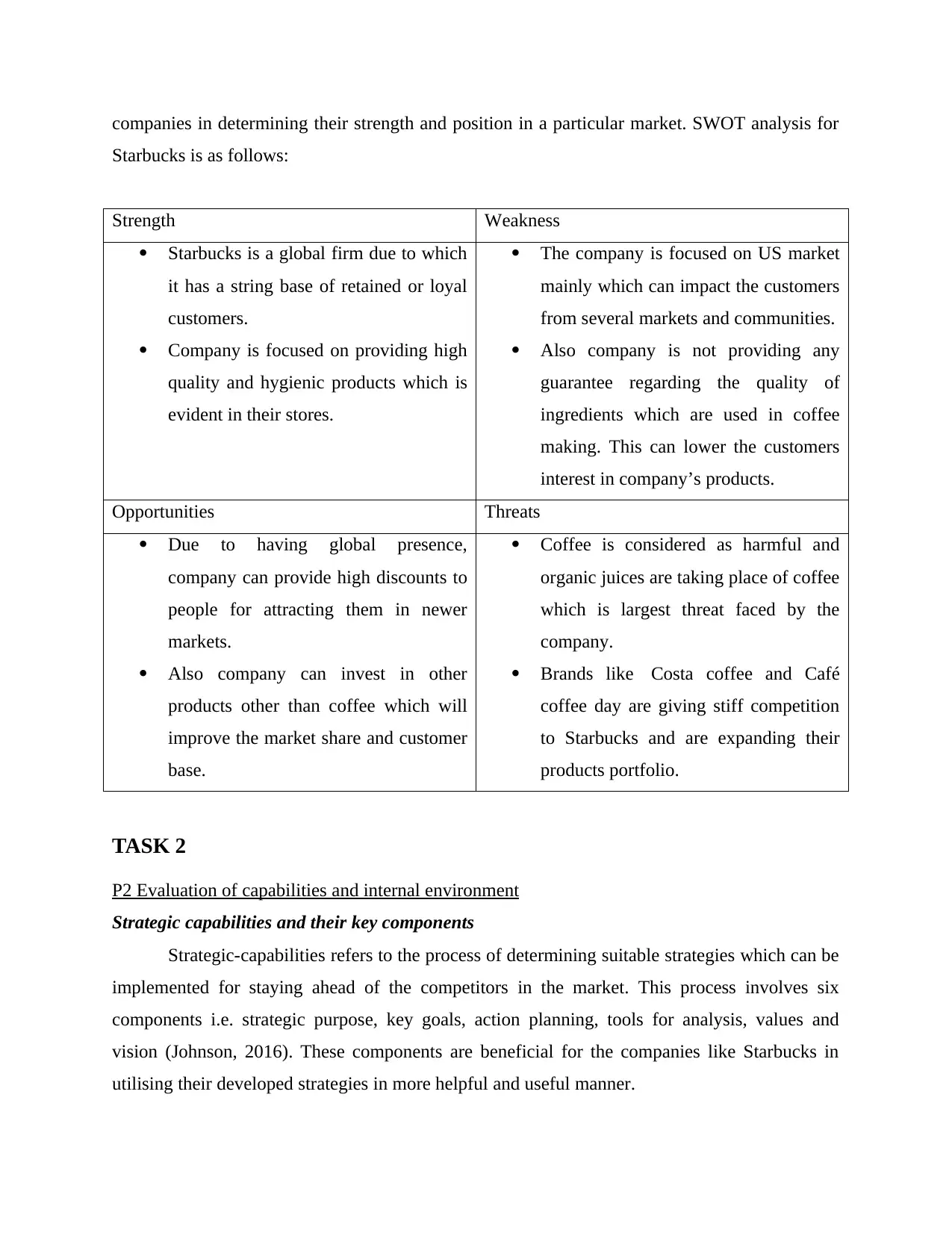
companies in determining their strength and position in a particular market. SWOT analysis for
Starbucks is as follows:
Strength Weakness
Starbucks is a global firm due to which
it has a string base of retained or loyal
customers.
Company is focused on providing high
quality and hygienic products which is
evident in their stores.
The company is focused on US market
mainly which can impact the customers
from several markets and communities.
Also company is not providing any
guarantee regarding the quality of
ingredients which are used in coffee
making. This can lower the customers
interest in company’s products.
Opportunities Threats
Due to having global presence,
company can provide high discounts to
people for attracting them in newer
markets.
Also company can invest in other
products other than coffee which will
improve the market share and customer
base.
Coffee is considered as harmful and
organic juices are taking place of coffee
which is largest threat faced by the
company.
Brands like Costa coffee and Café
coffee day are giving stiff competition
to Starbucks and are expanding their
products portfolio.
TASK 2
P2 Evaluation of capabilities and internal environment
Strategic capabilities and their key components
Strategic-capabilities refers to the process of determining suitable strategies which can be
implemented for staying ahead of the competitors in the market. This process involves six
components i.e. strategic purpose, key goals, action planning, tools for analysis, values and
vision (Johnson, 2016). These components are beneficial for the companies like Starbucks in
utilising their developed strategies in more helpful and useful manner.
Starbucks is as follows:
Strength Weakness
Starbucks is a global firm due to which
it has a string base of retained or loyal
customers.
Company is focused on providing high
quality and hygienic products which is
evident in their stores.
The company is focused on US market
mainly which can impact the customers
from several markets and communities.
Also company is not providing any
guarantee regarding the quality of
ingredients which are used in coffee
making. This can lower the customers
interest in company’s products.
Opportunities Threats
Due to having global presence,
company can provide high discounts to
people for attracting them in newer
markets.
Also company can invest in other
products other than coffee which will
improve the market share and customer
base.
Coffee is considered as harmful and
organic juices are taking place of coffee
which is largest threat faced by the
company.
Brands like Costa coffee and Café
coffee day are giving stiff competition
to Starbucks and are expanding their
products portfolio.
TASK 2
P2 Evaluation of capabilities and internal environment
Strategic capabilities and their key components
Strategic-capabilities refers to the process of determining suitable strategies which can be
implemented for staying ahead of the competitors in the market. This process involves six
components i.e. strategic purpose, key goals, action planning, tools for analysis, values and
vision (Johnson, 2016). These components are beneficial for the companies like Starbucks in
utilising their developed strategies in more helpful and useful manner.
Paraphrase This Document
Need a fresh take? Get an instant paraphrase of this document with our AI Paraphraser
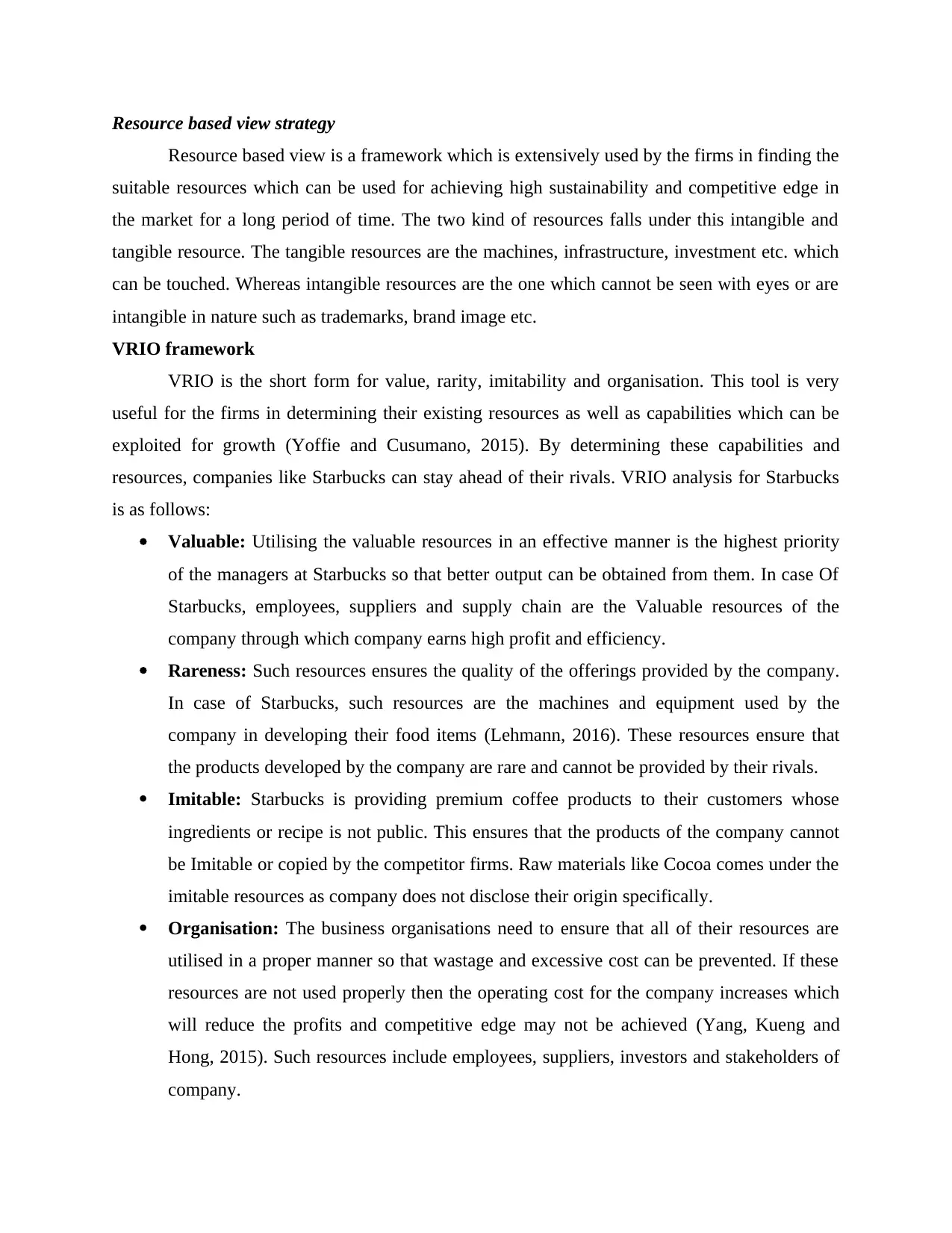
Resource based view strategy
Resource based view is a framework which is extensively used by the firms in finding the
suitable resources which can be used for achieving high sustainability and competitive edge in
the market for a long period of time. The two kind of resources falls under this intangible and
tangible resource. The tangible resources are the machines, infrastructure, investment etc. which
can be touched. Whereas intangible resources are the one which cannot be seen with eyes or are
intangible in nature such as trademarks, brand image etc.
VRIO framework
VRIO is the short form for value, rarity, imitability and organisation. This tool is very
useful for the firms in determining their existing resources as well as capabilities which can be
exploited for growth (Yoffie and Cusumano, 2015). By determining these capabilities and
resources, companies like Starbucks can stay ahead of their rivals. VRIO analysis for Starbucks
is as follows:
Valuable: Utilising the valuable resources in an effective manner is the highest priority
of the managers at Starbucks so that better output can be obtained from them. In case Of
Starbucks, employees, suppliers and supply chain are the Valuable resources of the
company through which company earns high profit and efficiency.
Rareness: Such resources ensures the quality of the offerings provided by the company.
In case of Starbucks, such resources are the machines and equipment used by the
company in developing their food items (Lehmann, 2016). These resources ensure that
the products developed by the company are rare and cannot be provided by their rivals.
Imitable: Starbucks is providing premium coffee products to their customers whose
ingredients or recipe is not public. This ensures that the products of the company cannot
be Imitable or copied by the competitor firms. Raw materials like Cocoa comes under the
imitable resources as company does not disclose their origin specifically.
Organisation: The business organisations need to ensure that all of their resources are
utilised in a proper manner so that wastage and excessive cost can be prevented. If these
resources are not used properly then the operating cost for the company increases which
will reduce the profits and competitive edge may not be achieved (Yang, Kueng and
Hong, 2015). Such resources include employees, suppliers, investors and stakeholders of
company.
Resource based view is a framework which is extensively used by the firms in finding the
suitable resources which can be used for achieving high sustainability and competitive edge in
the market for a long period of time. The two kind of resources falls under this intangible and
tangible resource. The tangible resources are the machines, infrastructure, investment etc. which
can be touched. Whereas intangible resources are the one which cannot be seen with eyes or are
intangible in nature such as trademarks, brand image etc.
VRIO framework
VRIO is the short form for value, rarity, imitability and organisation. This tool is very
useful for the firms in determining their existing resources as well as capabilities which can be
exploited for growth (Yoffie and Cusumano, 2015). By determining these capabilities and
resources, companies like Starbucks can stay ahead of their rivals. VRIO analysis for Starbucks
is as follows:
Valuable: Utilising the valuable resources in an effective manner is the highest priority
of the managers at Starbucks so that better output can be obtained from them. In case Of
Starbucks, employees, suppliers and supply chain are the Valuable resources of the
company through which company earns high profit and efficiency.
Rareness: Such resources ensures the quality of the offerings provided by the company.
In case of Starbucks, such resources are the machines and equipment used by the
company in developing their food items (Lehmann, 2016). These resources ensure that
the products developed by the company are rare and cannot be provided by their rivals.
Imitable: Starbucks is providing premium coffee products to their customers whose
ingredients or recipe is not public. This ensures that the products of the company cannot
be Imitable or copied by the competitor firms. Raw materials like Cocoa comes under the
imitable resources as company does not disclose their origin specifically.
Organisation: The business organisations need to ensure that all of their resources are
utilised in a proper manner so that wastage and excessive cost can be prevented. If these
resources are not used properly then the operating cost for the company increases which
will reduce the profits and competitive edge may not be achieved (Yang, Kueng and
Hong, 2015). Such resources include employees, suppliers, investors and stakeholders of
company.

TASK 3
P3: Porter’s five forces for evaluating competitive forces
Porter five forces is a simple tool for determining the competition in an industry. This tool
comes with 5 strategies through which competitive edge of a corporation can be identified. These
strategies in respect to Starbucks are as follows:
Threat of new entrants: Starbucks is operating in Coffee industry in which small
investment is needed to start a brand. These newly started brands can give competition to
Starbucks at local level which is not a matter of concern for the company. The threat of new
entrants for Starbucks is moderate. Also company has strong global presence due to which
company faces very low competition from rivalry firms.
Threat of Substitutes: There are several alternatives to the Starbucks products in the
market such as Juices, tea, Softdrinks etc. due to this the threat of substitute products is moderate
to high. People can also switch to home made products whose cost is not high as compared to
Starbucks premium products. This makes the threat a little big. However the company is
providing ambience, customer satisfaction and premium products to customers which restricts
this threat to moderate level upto some extent.
Bargaining power of buyers: The customers of Starbucks prefer the high quality products
of the company and there are few alternative for the company due to which the bargaining power
of customers is moderate (Leonidou and et. Al., 2015). However the excessive prices can impact
the firm as people look out for new trends and does not hesitate in switching to another brand if
prices becomes too high.
Bargaining power of suppliers: The bargaining power of suppliers for Starbucks is low
as the company has a number of suppliers who provides their products to firm. The company is
growing the coffee along with the farmers which has improved the supply chain, Company is
doing great in educating the farmers which is also strengthening the relationship between them.
Also the suppliers are large in numbers so if any supplier switches the prices then company can
opt another at its place.
Competitive rivalry: The entry and exit barriers for the firm in Coffee products are small
due to which large number of firms is competing along with Starbucks. However Starbucks is a
known brand for its premium and quality based products. The market share as well as position of
P3: Porter’s five forces for evaluating competitive forces
Porter five forces is a simple tool for determining the competition in an industry. This tool
comes with 5 strategies through which competitive edge of a corporation can be identified. These
strategies in respect to Starbucks are as follows:
Threat of new entrants: Starbucks is operating in Coffee industry in which small
investment is needed to start a brand. These newly started brands can give competition to
Starbucks at local level which is not a matter of concern for the company. The threat of new
entrants for Starbucks is moderate. Also company has strong global presence due to which
company faces very low competition from rivalry firms.
Threat of Substitutes: There are several alternatives to the Starbucks products in the
market such as Juices, tea, Softdrinks etc. due to this the threat of substitute products is moderate
to high. People can also switch to home made products whose cost is not high as compared to
Starbucks premium products. This makes the threat a little big. However the company is
providing ambience, customer satisfaction and premium products to customers which restricts
this threat to moderate level upto some extent.
Bargaining power of buyers: The customers of Starbucks prefer the high quality products
of the company and there are few alternative for the company due to which the bargaining power
of customers is moderate (Leonidou and et. Al., 2015). However the excessive prices can impact
the firm as people look out for new trends and does not hesitate in switching to another brand if
prices becomes too high.
Bargaining power of suppliers: The bargaining power of suppliers for Starbucks is low
as the company has a number of suppliers who provides their products to firm. The company is
growing the coffee along with the farmers which has improved the supply chain, Company is
doing great in educating the farmers which is also strengthening the relationship between them.
Also the suppliers are large in numbers so if any supplier switches the prices then company can
opt another at its place.
Competitive rivalry: The entry and exit barriers for the firm in Coffee products are small
due to which large number of firms is competing along with Starbucks. However Starbucks is a
known brand for its premium and quality based products. The market share as well as position of
⊘ This is a preview!⊘
Do you want full access?
Subscribe today to unlock all pages.

Trusted by 1+ million students worldwide
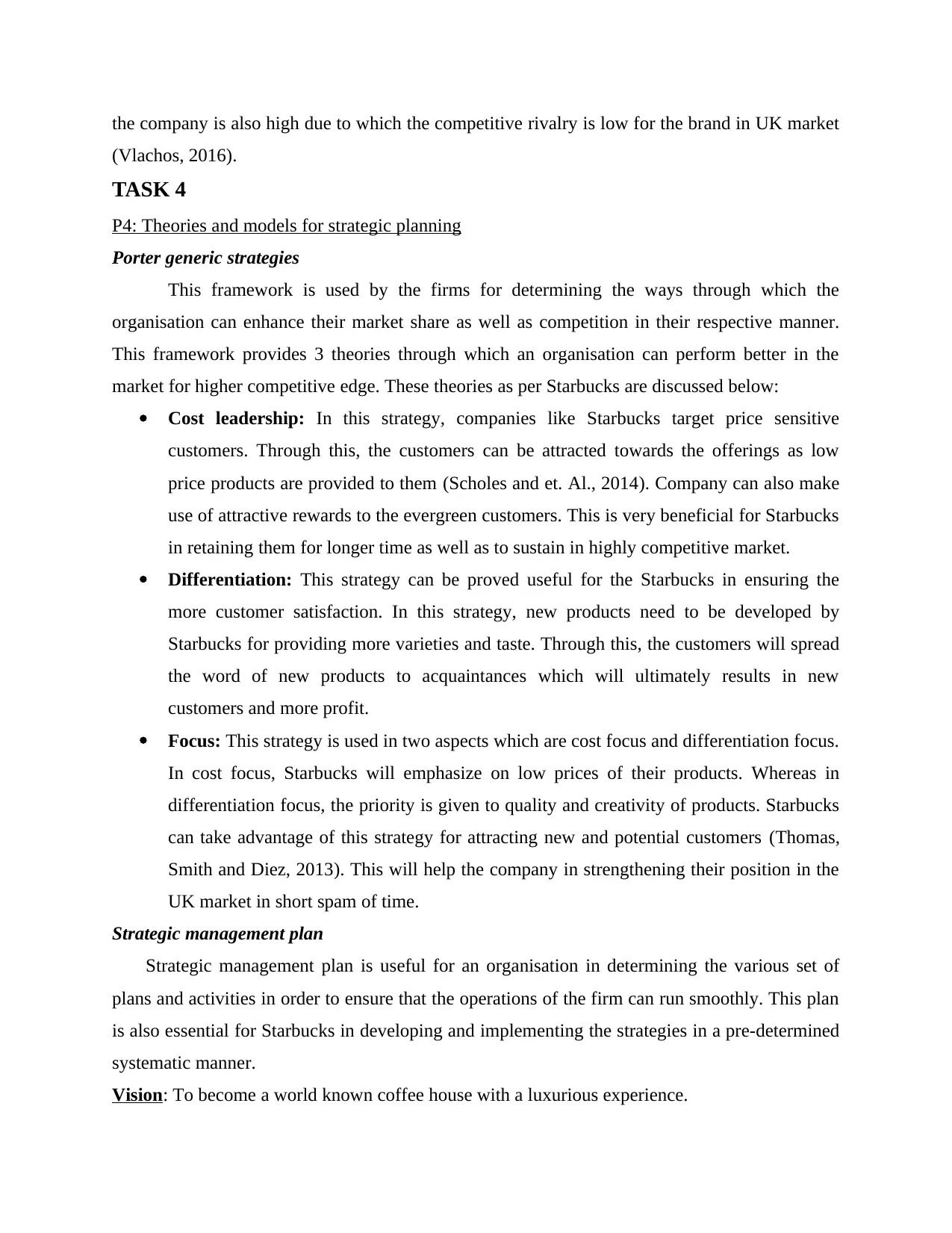
the company is also high due to which the competitive rivalry is low for the brand in UK market
(Vlachos, 2016).
TASK 4
P4: Theories and models for strategic planning
Porter generic strategies
This framework is used by the firms for determining the ways through which the
organisation can enhance their market share as well as competition in their respective manner.
This framework provides 3 theories through which an organisation can perform better in the
market for higher competitive edge. These theories as per Starbucks are discussed below:
Cost leadership: In this strategy, companies like Starbucks target price sensitive
customers. Through this, the customers can be attracted towards the offerings as low
price products are provided to them (Scholes and et. Al., 2014). Company can also make
use of attractive rewards to the evergreen customers. This is very beneficial for Starbucks
in retaining them for longer time as well as to sustain in highly competitive market.
Differentiation: This strategy can be proved useful for the Starbucks in ensuring the
more customer satisfaction. In this strategy, new products need to be developed by
Starbucks for providing more varieties and taste. Through this, the customers will spread
the word of new products to acquaintances which will ultimately results in new
customers and more profit.
Focus: This strategy is used in two aspects which are cost focus and differentiation focus.
In cost focus, Starbucks will emphasize on low prices of their products. Whereas in
differentiation focus, the priority is given to quality and creativity of products. Starbucks
can take advantage of this strategy for attracting new and potential customers (Thomas,
Smith and Diez, 2013). This will help the company in strengthening their position in the
UK market in short spam of time.
Strategic management plan
Strategic management plan is useful for an organisation in determining the various set of
plans and activities in order to ensure that the operations of the firm can run smoothly. This plan
is also essential for Starbucks in developing and implementing the strategies in a pre-determined
systematic manner.
Vision: To become a world known coffee house with a luxurious experience.
(Vlachos, 2016).
TASK 4
P4: Theories and models for strategic planning
Porter generic strategies
This framework is used by the firms for determining the ways through which the
organisation can enhance their market share as well as competition in their respective manner.
This framework provides 3 theories through which an organisation can perform better in the
market for higher competitive edge. These theories as per Starbucks are discussed below:
Cost leadership: In this strategy, companies like Starbucks target price sensitive
customers. Through this, the customers can be attracted towards the offerings as low
price products are provided to them (Scholes and et. Al., 2014). Company can also make
use of attractive rewards to the evergreen customers. This is very beneficial for Starbucks
in retaining them for longer time as well as to sustain in highly competitive market.
Differentiation: This strategy can be proved useful for the Starbucks in ensuring the
more customer satisfaction. In this strategy, new products need to be developed by
Starbucks for providing more varieties and taste. Through this, the customers will spread
the word of new products to acquaintances which will ultimately results in new
customers and more profit.
Focus: This strategy is used in two aspects which are cost focus and differentiation focus.
In cost focus, Starbucks will emphasize on low prices of their products. Whereas in
differentiation focus, the priority is given to quality and creativity of products. Starbucks
can take advantage of this strategy for attracting new and potential customers (Thomas,
Smith and Diez, 2013). This will help the company in strengthening their position in the
UK market in short spam of time.
Strategic management plan
Strategic management plan is useful for an organisation in determining the various set of
plans and activities in order to ensure that the operations of the firm can run smoothly. This plan
is also essential for Starbucks in developing and implementing the strategies in a pre-determined
systematic manner.
Vision: To become a world known coffee house with a luxurious experience.
Paraphrase This Document
Need a fresh take? Get an instant paraphrase of this document with our AI Paraphraser
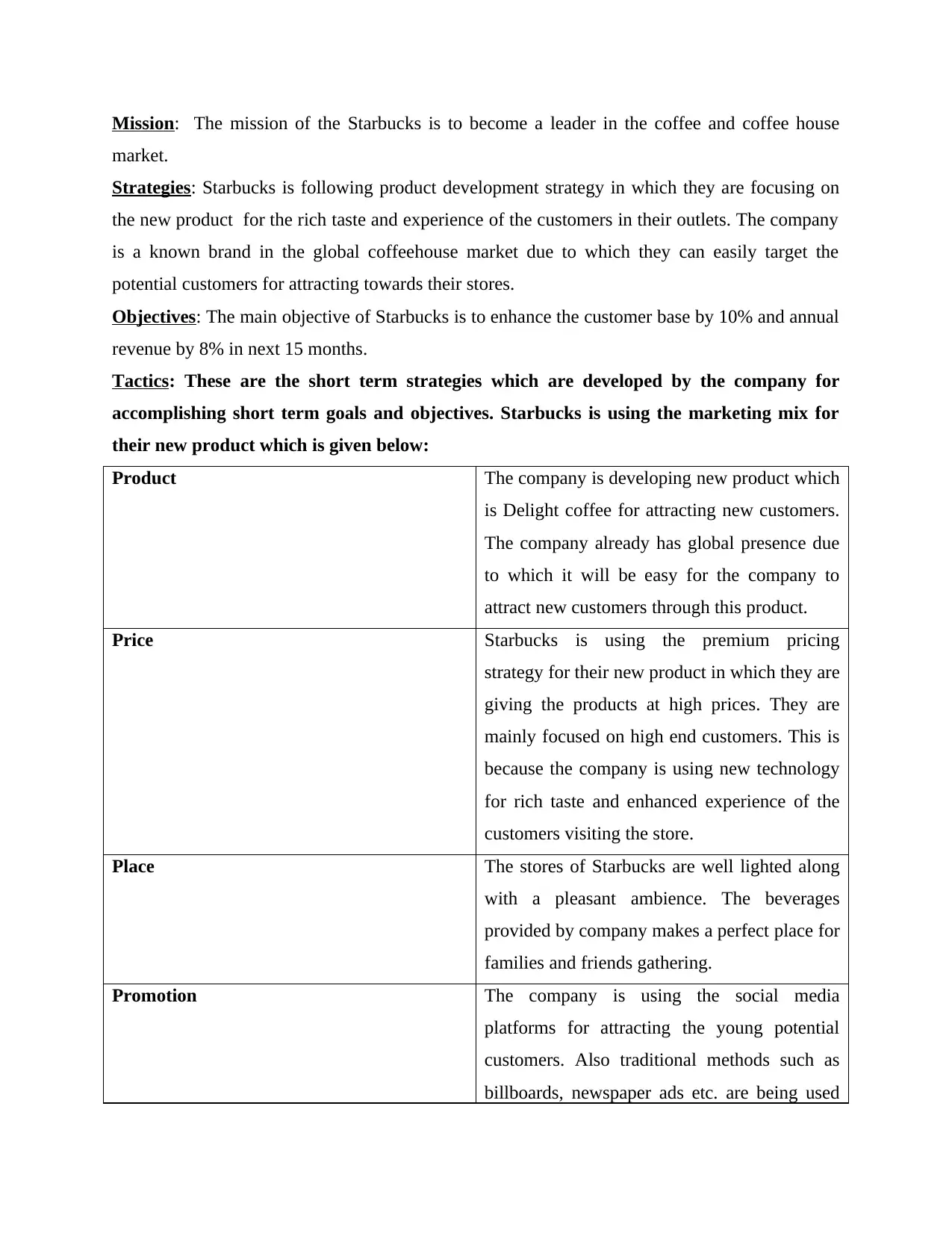
Mission: The mission of the Starbucks is to become a leader in the coffee and coffee house
market.
Strategies: Starbucks is following product development strategy in which they are focusing on
the new product for the rich taste and experience of the customers in their outlets. The company
is a known brand in the global coffeehouse market due to which they can easily target the
potential customers for attracting towards their stores.
Objectives: The main objective of Starbucks is to enhance the customer base by 10% and annual
revenue by 8% in next 15 months.
Tactics: These are the short term strategies which are developed by the company for
accomplishing short term goals and objectives. Starbucks is using the marketing mix for
their new product which is given below:
Product The company is developing new product which
is Delight coffee for attracting new customers.
The company already has global presence due
to which it will be easy for the company to
attract new customers through this product.
Price Starbucks is using the premium pricing
strategy for their new product in which they are
giving the products at high prices. They are
mainly focused on high end customers. This is
because the company is using new technology
for rich taste and enhanced experience of the
customers visiting the store.
Place The stores of Starbucks are well lighted along
with a pleasant ambience. The beverages
provided by company makes a perfect place for
families and friends gathering.
Promotion The company is using the social media
platforms for attracting the young potential
customers. Also traditional methods such as
billboards, newspaper ads etc. are being used
market.
Strategies: Starbucks is following product development strategy in which they are focusing on
the new product for the rich taste and experience of the customers in their outlets. The company
is a known brand in the global coffeehouse market due to which they can easily target the
potential customers for attracting towards their stores.
Objectives: The main objective of Starbucks is to enhance the customer base by 10% and annual
revenue by 8% in next 15 months.
Tactics: These are the short term strategies which are developed by the company for
accomplishing short term goals and objectives. Starbucks is using the marketing mix for
their new product which is given below:
Product The company is developing new product which
is Delight coffee for attracting new customers.
The company already has global presence due
to which it will be easy for the company to
attract new customers through this product.
Price Starbucks is using the premium pricing
strategy for their new product in which they are
giving the products at high prices. They are
mainly focused on high end customers. This is
because the company is using new technology
for rich taste and enhanced experience of the
customers visiting the store.
Place The stores of Starbucks are well lighted along
with a pleasant ambience. The beverages
provided by company makes a perfect place for
families and friends gathering.
Promotion The company is using the social media
platforms for attracting the young potential
customers. Also traditional methods such as
billboards, newspaper ads etc. are being used
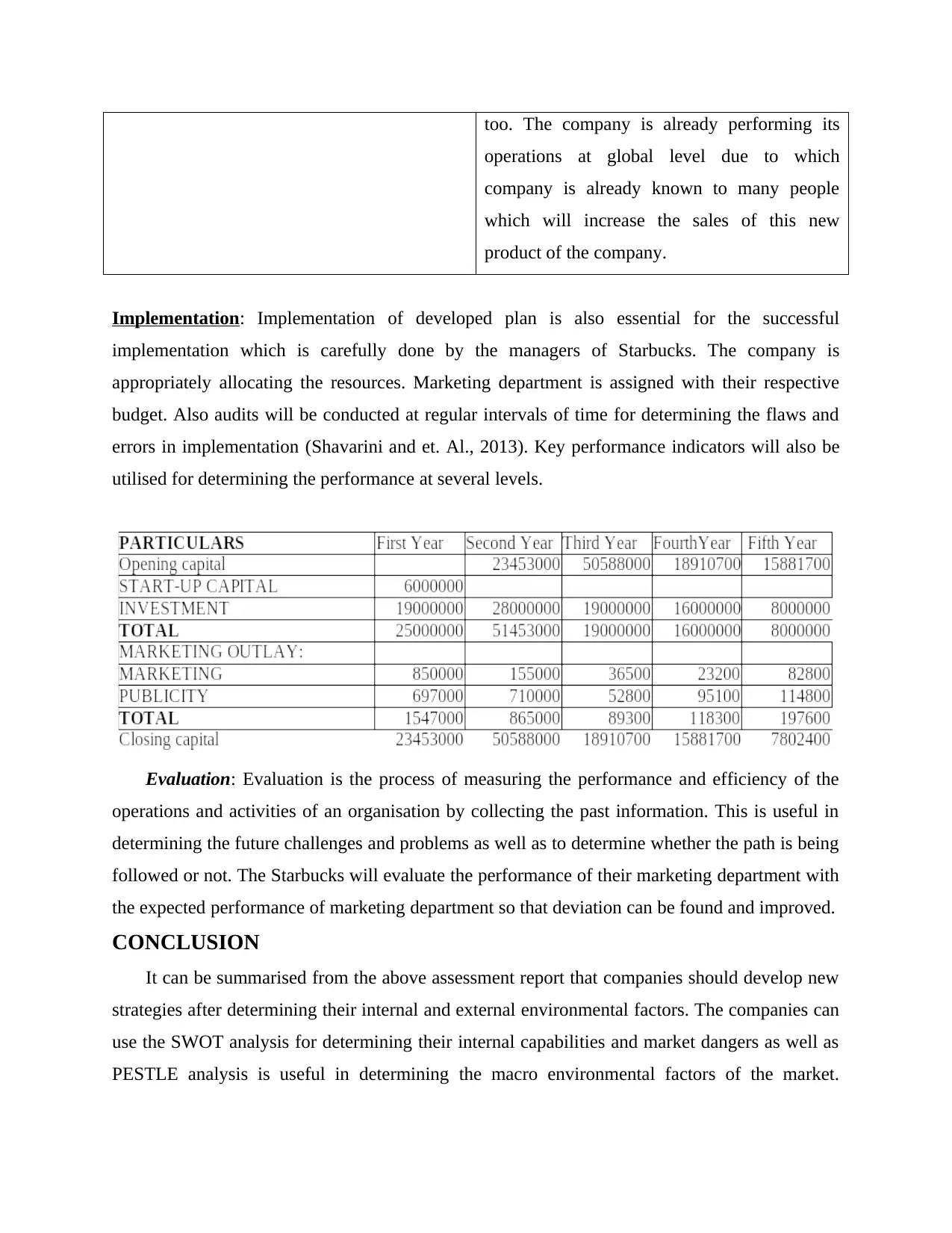
too. The company is already performing its
operations at global level due to which
company is already known to many people
which will increase the sales of this new
product of the company.
Implementation: Implementation of developed plan is also essential for the successful
implementation which is carefully done by the managers of Starbucks. The company is
appropriately allocating the resources. Marketing department is assigned with their respective
budget. Also audits will be conducted at regular intervals of time for determining the flaws and
errors in implementation (Shavarini and et. Al., 2013). Key performance indicators will also be
utilised for determining the performance at several levels.
Evaluation: Evaluation is the process of measuring the performance and efficiency of the
operations and activities of an organisation by collecting the past information. This is useful in
determining the future challenges and problems as well as to determine whether the path is being
followed or not. The Starbucks will evaluate the performance of their marketing department with
the expected performance of marketing department so that deviation can be found and improved.
CONCLUSION
It can be summarised from the above assessment report that companies should develop new
strategies after determining their internal and external environmental factors. The companies can
use the SWOT analysis for determining their internal capabilities and market dangers as well as
PESTLE analysis is useful in determining the macro environmental factors of the market.
operations at global level due to which
company is already known to many people
which will increase the sales of this new
product of the company.
Implementation: Implementation of developed plan is also essential for the successful
implementation which is carefully done by the managers of Starbucks. The company is
appropriately allocating the resources. Marketing department is assigned with their respective
budget. Also audits will be conducted at regular intervals of time for determining the flaws and
errors in implementation (Shavarini and et. Al., 2013). Key performance indicators will also be
utilised for determining the performance at several levels.
Evaluation: Evaluation is the process of measuring the performance and efficiency of the
operations and activities of an organisation by collecting the past information. This is useful in
determining the future challenges and problems as well as to determine whether the path is being
followed or not. The Starbucks will evaluate the performance of their marketing department with
the expected performance of marketing department so that deviation can be found and improved.
CONCLUSION
It can be summarised from the above assessment report that companies should develop new
strategies after determining their internal and external environmental factors. The companies can
use the SWOT analysis for determining their internal capabilities and market dangers as well as
PESTLE analysis is useful in determining the macro environmental factors of the market.
⊘ This is a preview!⊘
Do you want full access?
Subscribe today to unlock all pages.

Trusted by 1+ million students worldwide
1 out of 14
Related Documents
Your All-in-One AI-Powered Toolkit for Academic Success.
+13062052269
info@desklib.com
Available 24*7 on WhatsApp / Email
![[object Object]](/_next/static/media/star-bottom.7253800d.svg)
Unlock your academic potential
Copyright © 2020–2025 A2Z Services. All Rights Reserved. Developed and managed by ZUCOL.



